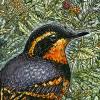

Join BirdNote tomorrow, November 30th!
Illustrator David Sibley and actor H. Jon Benjamin will face off in the bird illustration battle of the century during BirdNote's Year-end Celebration and Auction!
If any bird is an anomaly, it's the Wilson's Phalarope. In a birdbook, Wilson's Phalaropes are found among the sandpipers. But they forage while swimming. Spinning like tops, they create an upwelling, pulling food to the surface. The breeding of Wilson's Phalaropes is anomalous, too. Females are the brightly colored sex, and courtship roles are reversed: female phalaropes compete for males, and, once they lay eggs, leave all parental duties to the males. In common with many birds, though, Wilson's Phalaropes face conservation challenges.
BirdNote®
The Anomalous Wilson’s Phalarope
Written by Bob Sundstrom
This is BirdNote.
[Call of Wilson’s Phalarope]
The dictionary defines “anomaly” as something difficult to classify – a departure from the rule. If any bird meets that description, it’s the Wilson’s Phalarope. [Continue call of Wilson’s Phalarope]
In a bird book, Wilson’s Phalaropes are found among the sandpipers – and in fact they do have the long, slender sandpiper bill, but, instead of probing tide flats, they forage while swimming, alongside ducks. They spin like tops on the water. That creates an upwelling, pulling food to the surface which the birds pick up. [Wilson’s Phalarope call notes]
The breeding of Wilson’s Phalaropes is even more unusual. Females are the brightly colored sex, opposite of most birds, and courtship roles are reversed: females compete for males, sometimes mate with several and, once they lay eggs, leave all parental duties to the males. In summer, Wilson’s Phalaropes nest in prairie wetlands in the northern half of the western United States, and well into Canada, but come winter they head south — some as far as Argentina.
In common with most birds, however, Wilson’s Phalaropes face conservation challenges, particularly when it comes to the protection of their winter habitat. [Wilson’s Phalarope call notes]
To learn more about the anomalous phalarope, come to our website: BirdNote.org. I’m Mary McCann.
###
Calls of Wilson’s Phalarope provided by The Macaulay Library of Natural Sounds at the Cornell Lab of Ornithology, Ithaca, New York. 3208 recorded by R.S. Little; 105882 R.C. Fawcett.
BirdNote’s theme music was composed and played by Nancy Rumbel and John Kessler.
Producer: John Kessler
Executive Producer: Chris Peterson
© 2015 Tune In to Nature.org July 2017/2020 February 2023 Narrator: Mary McCann
ID# SotB-WIPH-01b-2020-7-26







